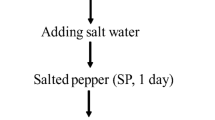Abstract
A sensitive, precise, and specific ultra high performance liquid chromatographic (u-HPLC) method was developed for the analysis of capsaicin in foods. The method validation parameters yielded good results, including linearity, precision, accuracy, and recovery. The u-HPLC separation was performed on a reversed column C18 (particle size 2 μm, i.d. 2 mm, length 50 mm, followed by fluorescence detection-excitation 280 nm, emission 325 nm). The recovery of capsaicin in gochujang was more than 91%, and the detection limit and lower determination limit of u-HPLC analysis were 0.054 and 0.163 μg/mL for capsaicin and 0.053 and 0.160 μg/mL for dihydrocapsaicin, respectively. The calibration graph for capsaicin and dihydrocapsaicin was linear from 0.2 to 10.0 μg/mL for u-HPLC analysis. The inter-day and intra-day precisions (relative standard deviations) were <5.21% for capsaicin and <9.79% for dihydrocapsaicin while the average recoveries obtained were quantitative 91.1–94.8% for capsaicin, 91.4–97.0% for dihydrocapsacin, indicating good accuracy of the u-HPLC method.
Similar content being viewed by others
References
Todd PH, Bensinger MG, Riftu T. Determination of pungency due to capsaicum by gas-liquid chromatography. J. Food Sci. 42: 660–665 (1977)
Iwai K, Suzuki T, Fujiwake H. Simultaneous microdetermination of capsaicin and its four analogs by using high-performance liquid chromatography and gas chromatography-mass spectrometry. J. Chromatogr. 172: 303–311 (1979)
Reilly CA, Crouch DJ, Yost GS. Quantitative analysis of capsaicinoids in fresh peppers oleoresin capsicum and pepper spray products. J. Forensic Sci. 46: 502–509 (2001)
Chiang GH. HPLC analysis of capsaicins and simultaneous determination of capsaicins and pipeine by HPLCECD and UV. J. Food Sci. 51: 499–503 (1986)
Perucka I, Oleszek W. Extraction and determination of capsaicinoids in fruit of hot pepper Capsicum annuum L. by spectrophotometry and high-performance liquid chromatography. Food Chem. 71: 287–291 (2000)
AOAC. Official Method of Analysis of AOAC Intl. 18th ed. Method 995.03. Association of Official Analytical Chemists, Gaithersburg, MD, USA (2005)
Kim KS, Park JB, Kim SA. Quality characterisitics of gochujang prepared with Korean single-harvested pepper (Capsicum annuum L.). J. Korean Soc. Food Sci. Nutr. 36: 759–765 (2007)
Chae IS, Kim HS, Ko YS, Kang MH, Hong SP, Shin D. Effect of citrus concentrate on the physicchemical properties of gochujang. Korean J. Food Sci. Technol. 40: 626–632 (2008)
Kwon DJ. Quality improvement of gochujang using Cordyceps sp. Korean J. Food Sci. Technol. 36: 81–85 (2004)
Oh HI, Park JM. Changes in quality characteristics of traditional gochujang prepared with a meju of different fermentation period during aging. Korean J. Food Sci. Technol. 29: 1166–1174 (1997)
Reilly CA, Crouch DJ, Yost GS. Quantitative anlaysis of capsaicinoids in fresh peppers, oleoresin capsicum, and pepper spray products. J. Forensic Sci. 46: 502–509 (2001)
Ha J, Han KJ, Kim KJ, Jeong SW. Gas chromatographic analysis capsaicin in gochujang. J. AOAC Int. 91: 387–391 (2008)
Hawer W, Ha J, Hwang J, Nam Y. Effective separation and quantitative analysis of major heat principles in red pepper by gas chromatography. Food Chem. 49: 99–103 (1994)
Estella-Hermoso MA, Campanero MA, Mollinedo F, Blanco-Prieto MJ. Comparative study of A HPLC-MS assay versus an UHPLCMS/MS for anti-tumoral alkyl lysophospholipid edelfosine determination in both biological samples and in lipid nanoparticulate systems J. Chromatogr. B. 877: 4035–4041 (2009)
Marin JM, Gracia-Lor E, Sancho JV, Lopez FJ, Hernandez, F. Application of ultra-high-pressure liquid chromatography-tandem mass spectrometry to the determination of multi-class pesticides in environmental and wastewater samples study of matrix effects. J. Chromatogr. A. 1216: 1410–1420 (2009)
Hoffman PG, Lego MC, Galetto WG. Separation and quantitation of red pepper major heat principles by reverse high performance liquid chromatography. J. Agr. Food Chem. 31: 1326–1330 (1983)
Saria A, Lembeck F, Skofitsch G. Determination of capsaicin analogues by high performance liquid chromatography. J. Chromatogr. 208: 41–46 (1981)
Author information
Authors and Affiliations
Corresponding author
Rights and permissions
About this article
Cite this article
Ha, J., Seo, HY., Shim, YS. et al. Determination of capsaicinoids in foods using ultra high performance liquid chromatography. Food Sci Biotechnol 19, 1005–1009 (2010). https://doi.org/10.1007/s10068-010-0141-8
Received:
Revised:
Accepted:
Published:
Issue Date:
DOI: https://doi.org/10.1007/s10068-010-0141-8




